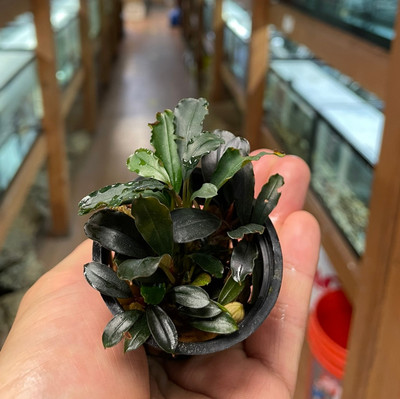Bucephalandra in Aquariums: A Detailed Guide
Posted by Max Gandara on on 14th Sep 2023
Aquascaping, the art of creating visually appealing underwater
landscapes, has gained immense popularity in recent years. To achieve a
stunning aquascape, aquarists often turn to unique and eye-catching
aquatic plants. Bucephalandra, a genus of rhizomatous plants native to
Borneo, has emerged as a favorite among aquarists for its captivating
appearance and ease of care. In this detailed guide, we will explore the
world of Bucephalandra in aquariums, including its background, care
requirements, propagation, and design ideas.
I. Background of Bucephalandra
Bucephalandra belongs to the Araceae family and is closely related to
Anubias and Cryptocoryne plants. The genus is named after the famous
horse of Alexander the Great, Bucephalus. These plants are known for
their striking, often metallic, colors and intricate leaf shapes.
Bucephalandra is typically found growing submerged along riverbanks and
streams in Borneo's dense tropical rainforests.
II. Care Requirements
1. Lighting: Bucephalandra species thrive in moderate to low light
conditions. They can adapt to various lighting setups, making them
suitable for both beginners and experienced aquarists. However, to bring
out their vibrant colors, it's recommended to provide moderate
lighting.
2. Water Parameters:
- Temperature: Bucephalandra prefers water temperatures between 72°F to 82°F (22°C to 28°C).
- pH Level: They thrive in slightly acidic to neutral water with a pH range of 6.0 to 7.5.
- Water Hardness: Soft to moderately hard water is ideal, with a dGH of 2-15.
3. Substrate: Use a fine-grained substrate like sand or aquasoil to
anchor Bucephalandra. Attach them to rocks or driftwood using super glue
gel or thread until their rhizomes establish themselves.
4. Fertilization: These plants are relatively undemanding, but they
benefit from occasional root tab fertilization or liquid fertilizers
with micronutrients.
5. Water Flow: Bucephalandra appreciates gentle water movement, so ensure your aquarium has proper circulation.
III. Propagation
Bucephalandra can be propagated through several methods:
1. Rhizome Division: Gently separate the rhizomes and attach the divided
portions to new surfaces. This method is effective and ensures genetic
consistency.
2. Leaf Cuttings: Trim healthy leaves and plant them in the substrate or
attach them to driftwood or rocks. New plants will sprout from the leaf
nodes.
3. Tissue Culture: Some nurseries offer tissue-cultured Bucephalandra,
which ensures sterile and disease-free plants. These can be divided and
planted as well.
IV. Aquascape Design Ideas
Bucephalandra can be used to create stunning aquascapes, and here are some design ideas:
1. The Bucephalandra Carpet: Cover the foreground of your aquarium with a
lush carpet of Bucephalandra species. This creates a vibrant and
visually appealing base.
2. Driftwood and Rocks: Attach Bucephalandra to driftwood or rocks to create focal points and add texture to your aquascape.
3. Mixed Plant Layout: Combine Bucephalandra with other aquatic plants
like mosses, Anubias, and Cryptocorynes for a diverse and natural look.
4. Terrariums and Paludariums: Bucephalandra can also be used in setups
that partially emerge from the water, like terrariums and paludariums.
Bucephalandra is a captivating and low-maintenance aquatic plant that
can elevate the beauty of any aquarium. With their unique colors and
textures, these plants offer endless possibilities for aquascaping
enthusiasts. By following the care guidelines and exploring creative
design ideas, you can incorporate Bucephalandra into your aquarium and
create a mesmerizing underwater world.

